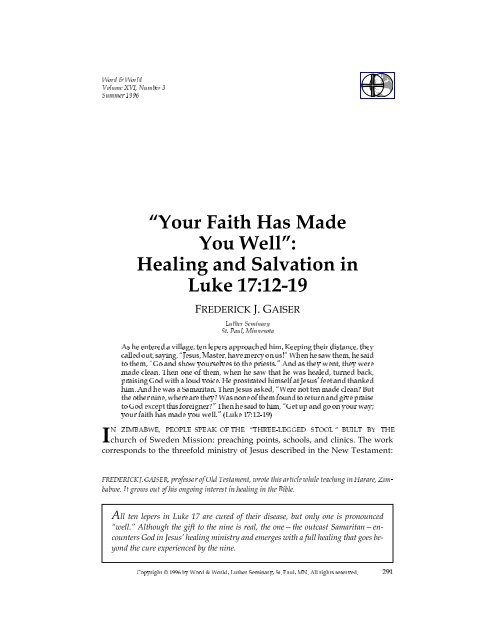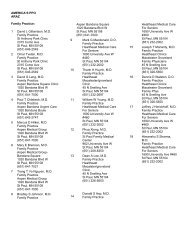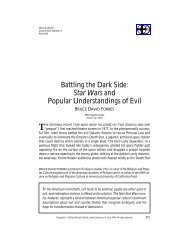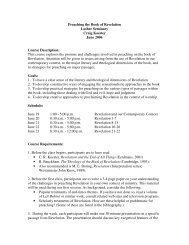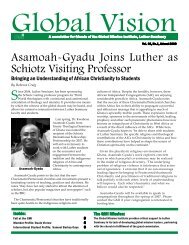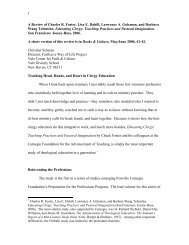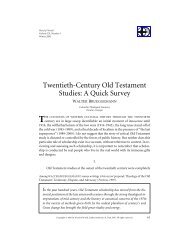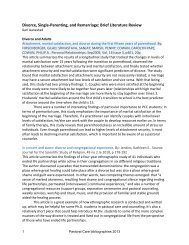Your Faith Has Made You Well - Word & World - Luther Seminary
Your Faith Has Made You Well - Word & World - Luther Seminary
Your Faith Has Made You Well - Word & World - Luther Seminary
- No tags were found...
You also want an ePaper? Increase the reach of your titles
YUMPU automatically turns print PDFs into web optimized ePapers that Google loves.
<strong>Word</strong> & <strong>World</strong>Volume XVI, Number 3Summer 1996“<strong><strong>You</strong>r</strong> <strong>Faith</strong> <strong>Has</strong> <strong>Made</strong><strong>You</strong> <strong>Well</strong>”:Healing and Salvation inLuke 17:12-19FREDERICK J. GAISER<strong>Luther</strong> <strong>Seminary</strong>St. Paul, MinnesotaAs he entered a village, ten lepers approached him. Keeping their distance, theycalled out, saying, “Jesus, Master, have mercy on us!” When he saw them, he saidto them, “Go and show yourselves to the priests.” And as they went, they weremade clean. Then one of them, when he saw that he was healed, turned back,praising God with a loud voice. He prostrated himself at Jesus’ feet and thankedhim. And he was a Samaritan. Then Jesus asked, “Were not ten made clean? Butthe other nine, where are they? Was none of them found to return and give praiseto God except this foreigner?” Then he said to him, “Get up and go on your way;your faith has made you well.” (Luke 17:12-19)IN ZIMBABWE, PEOPLE SPEAK OF THE “THREE-LEGGED STOOL ” BUILT BY THEchurch of Sweden Mission: preaching points, schools, and clinics. The workcorresponds to the threefold ministry of Jesus described in the New Testament:FREDERICK J. GAISER, professor of Old Testament, wrote this article while teaching in Harare, Zimbabwe.It grows out of his ongoing interest in healing in the Bible.All ten lepers in Luke 17 are cured of their disease, but only one is pronounced“well.” Although the gift to the nine is real, the one—the outcast Samaritan—encountersGod in Jesus’ healing ministry and emerges with a full healing that goes beyondthe cure experienced by the nine.Copyright © 1996 by <strong>Word</strong> & <strong>World</strong>, <strong>Luther</strong> <strong>Seminary</strong>, St. Paul, MN. All rights reserved. 291
Gaiserpreaching, teaching, and healing (Matt 4:23). 1While the gospel of forgivenesswas the foundation of all the mission’s work, like its Lord it recognized the people’sneed also for teaching and healing.In the Gospel of Luke, we find Jesus responding to needs in a variety ofways. To the woman with the alabaster jar, “who was a sinner,” Jesus said, “<strong><strong>You</strong>r</strong>sins are forgiven....<strong><strong>You</strong>r</strong> faith has saved you” (Luke 7:36-50). The Samaritan leper,though, wanted something else—to be free of leprosy. And to him Jesus said, “<strong><strong>You</strong>r</strong>faith has made you well” (Luke 17:19). In Luke’s Gospel, of course, Jesus says thesame thing to both of them: “hJ pivsti" sou sevswkevn se.” What does this mean?Why is sevswkevn sometimes translated “saved” and sometimes “made well”? 2I. HEALING AND CURETo understand the relation between healing and salvation, as depicted byLuke, we will need to consider another distinction, one made often these days inboth medical and popular literature, the distinction between healing and cure. Asclearly as anywhere, this was spelled out thirteen years ago by Richard E. YaDeauin the pages of this journal:Recognizing, then, that the triune being [the human] is composed of a physicalentity, a psycho-social entity, and a spiritual entity, curing becomes that endeavorwhich rectifies a disease or a disorder in one component of the triune being,while healing addresses the integration of these three components into asingle entity, and is independent of the extent to which an individual’s physicalbody is cured. 3To this technical description we can add, almost at will, more experiential ones,some of them remarkably compelling in their personal and literary power.Nancy Mairs, reflecting on her experience with multiple sclerosis, recognizesthat, though she was not being cured (i.e., freed from her limp, which is what sheactually wanted when she prayed, “God, God, God, please heal me!”), she was, infact, being healed, “made whole”—a process “which might entail collecting scatteredfragments and painstakingly fitting and gluing them into place.” “Since‘cure’ and ‘heal’ can be used interchangeably, I didn’t reflect before making mychoice.” She does not understand, she says, how a “relentless degeneration of mycentral nervous system can function to ‘heal’ me.” But “Why not? I wonderedthen. I still do.” 41Hugo Söderström, God Gave Growth: The History of the <strong>Luther</strong>an Church in Zimbabwe, 1903-1980(Gweru, Zimbabwe: <strong>Luther</strong>an Church in Zimbabwe, 1984) 48.2On the meaning of salvation in relation to healing, see: Terence E. Fretheim, “Salvation in the Biblevs. Salvation in the Church,” <strong>Word</strong> & <strong>World</strong> 13/4 (1993) 363-372; Donald E. Gowan, “Salvation asHealing,” Ex Auditu 5 (1989) 1-19; Theodore Peters, “Wholeness in Salvation and Healing,” <strong>Luther</strong>anQuarterly 5/3 (1991) 297-314; Mark Allan Powell, “Salvation in Luke-Acts,” <strong>Word</strong> & <strong>World</strong> 12/1 (1992)5-10; Claus Westermann, “Salvation and Healing in the Community: The Old Testament Understanding,”International Review of Mission 61/241 (1972) 8-19.3Richard E. YaDeau, “Healing,” <strong>Word</strong> & <strong>World</strong> 2/4 (1982) 317.4Nancy Mairs, Ordinary Time: Cycles in Marriage, <strong>Faith</strong>, and Renewal (Boston: Beacon, 1993) 178.292
Healing and Salvation in Luke 17:12-19Tony Hillerman, a recognized observer of Native American life in the southwest,makes a similar distinction:From the tiny speaker of the tiny recorder Chee was hearing the same chant.Talking God summoning the yei to the Naakhai ceremony on the final night ofthe Yeibichai, calling them for the ritual which would heal Mrs. Agnes Tsosieand restore her to harmony. Not cure her, because Agnes Tsosie was dying ofliver cancer. But heal her, return her to hozro, to harmony with her fate. 5These writers describe something real and profound, something no doubt essentialto any contemporary talk of healing.Often, this understanding of healing (rather than “mere” cure) is related inone way or another to the present interest in holism (or, to use YaDeau’s term, “integration”),an interest that deliberately sets itself over against the kind of differentiatedview of the world and of the human being that is the hallmark ofenlightenment thought. 6 Often this holistic view of healing seeks religious connections;just as Hillerman related healing to Navajo hozro, others seek connectionswith what the Bible calls shalom (
Gaisertional healing, and biblical healing require further study. Here, we will attempt tolook more carefully at the biblical world using the story of the healing (and/orcure?) of the ten lepers. 9Luke’s account does indeed seem to make a distinction between what mightbe called cure on the one hand and healing on the other. Ten are cured of thesymptoms of leprosy; one is pronounced “well” (sevswkevn). What is the difference?Jesus himself invites a comparison between the nine and the one; and such acomparison quickly reveals a careful literary structure in this pericope:Part OnePart Two[One sees]A Ten come to JesusA’ One comes to JesusB Ten keep distanceB’ One at Jesus’ feetC Ten lamentC’ One praises[Jesus sees][Interlude: theSamaritan issue]D Jesus sends the tenD’ Jesus sends the oneE Ten are cleansedE’ One is “well”Other than the interlude about the Samaritan issue and the differently placedobservations about seeing, the literary parallelism is exact. A comparison of the actionsin the two parts of the story will prove useful.1. The approach to Jesus. In part one, the ten approach, but keep their distance.This distance reminds us of their leprosy, of course; it is made necessary by the ritualuncleanness associated with the disease (Leviticus 13-14). But it also serves tocontrast the first part of the story with the second; for in part two the one prostrateshimself at Jesus’ feet. Here there is no longer distance, no longer uncleanness.The distance in part one is not only physical; it is theological as well.The approach by the ten in part one is simply the necessary approach ofthose seeking aid, the approach of the seeker, the petitioner, the lamenter. It issurely not to be despised, for it parallels the seeking of God in Old Testament worship.In part two of Luke’s account, however, something greater occurs. The onenot only “approaches” Jesus, he “turns back” (u&postrevfw) in order to do so.“Turning” is hardly an accidental action in the Bible. 109Whereas the examples cited above speak of “healing” that does not include “cure,” the full healingof the Samaritan leper includes cure also. This is most often the case in biblical healing stories. Althougheven cursory concordance work demonstrates that the biblical words for “healing” are broadand inclusive terms, including much more than physical cure, they most often do envision physical cureas well. One wonders whether, in the light of the biblical witness, the modern distinction between healingand cure might too quickly move beyond cure in its proper concern for healing.10While the text does not use e*pistrevfw, the term more often used in the New Testament to describea theological “turning,” u&postrevfw is not without its own significance. It can sometimes refer to asimple act of “returning” with no particular theological significance (so can e*pistrevfw), but on severaloccasions Luke relates the term to an encounter with Jesus or the gospel that results in a turning towardproclamationor prayer (Luke 8:39; 24:9, 33-35, 53-53; Acts 8:25; 14:21-22). Most significantly, perhaps, inhis own conversion, Saul, like the Samaritan leper, is given sight and then “turns” (u&postrevfw)todothe work of the gospel (Acts 22:13-17). In our story, the term gains significance because of Jesus’own expectation that all those cleansed should “turn” (v. 18). But, as we have seen, only one does294
Healing and Salvation in Luke 17:12-19The significance of the one’s turn is stressed by the goal of his journey. Priorto turning back, the Samaritan leper, with the nine others, was on his way to thepriests. It was the priests who could pronounce them clean, thus readmitting themto social intercourse and temple worship (i.e., the presence of God). If we ask thequestion raised by the <strong>World</strong> War II conservation posters, “Is this trip necessary?”the answer, in their social and theological world, was a clear yes. The way to thepriests was the way to social and ritual health, not merely physical health. Yet, theone does not continue on this path. Instead, he turns around and heads for Jesus.This is nothing less than a move from an Old Testament to a New Testamentworldview. For the one it is no longer the priests who define social status, but Jesus.It is no longer the priests who grant admission to God’s presence, but Jesus.The text does not despise the priests and their world, but it recognizes the presenceof something greater: the kingdom of God in the person of Jesus. The onewho will be termed “healed” has turned toward this greater reality.2. Seeing. Ten are cleansed; one “sees” (o&ravw) that he is cleansed. It is hardlynecessary to emphasize the significance of “seeing” in biblical theology. Throughoutthe Bible, sight to the blind is a preeminent gift and symbol of the divine presence.In Luke, Jesus reminds John’s disciples: “Go and tell John what you haveseen and heard: the blind receive their sight, the lame walk, the lepers arecleansed, the deaf hear, the dead are raised, the poor have good news brought tothem” (7:22). They are called to see (o&ravw) that the new world has broken in. 11Here is another Old Testament/New Testament move. Once more, the point is notto belittle the people of the Old Covenant. They bear their own rich and essentialwitness to the work of God in the world. But they have not seen Jesus, says Luke,whereas the disciples have. And now, so has the Samaritan leper. Nothing willever be the same.The leper’s seeing in part two (v. 15) parallels Jesus’ seeing in part one (v. 14).This is not the only passage in Luke where Jesus sees and has compassion (cf. 7:13;13:12). In this respect, Jesus’ seeing is like that of the father of the prodigal son(15:20)—but unlike that of the disciples, who see and rebuke (18:5), or of thecrowds, who see and murmur (19:7). Thus, to see (like the Samaritan) is to be likeJesus, to be with Jesus, to have taken one’s stand for the gospel.Why, in our story, are ten cleansed but only one sees? Why do some see andsome not? The question is not unique to this story, of course. Why—given thesame experiences—do some believe while others do not? Why, as Claus Westermannputs it, do some encounter God in their healing, while others do not? 12 The actof coming to faith remains a mystery in biblical theology and in human experience.3. Lament and praise. In part one of the story, ten lament (actually, ten petition,so (v. 15). In the LXX, too, u&postrevfw, when, used to translate bWv (“turn, repent”), normally carries asimple physical or geographical meaning. At least on one occasion, however, there is a strong theologicalsense. Sinaiticus uses u&postrevfw to speak of God’s “repentance”(turning away his wrath) in Prov 24:18.11“Seeing” (o&ravw) has messianic significance in other Lucan texts as well (cf. 2:26, 30; 9:32; 19:37;21:31; 23:47). Indeed, “many prophets and kings desired to see what you see, but did not see it” (10:24).12Westermann, “Salvation and Healing in the Community,” 13.295
Gaiserbut petition is one element of the biblical laments); in part two, one praises. Again,the point is not that there is anything wrong with lamentation. Indeed, the lamenthas an essential place in Old Testament theology. It is a faithful turning to God,part of the dialogue with God that shapes the future. It provides the occasion, infact, for God to be God, to act on Israel’s behalf (Exod 2:23-25; 3:7-10). 13No, there is nothing wrong with lament. The problem is that we hear nothingmore from the nine, whereas, as we know from both individual psalms and theshape of the Psalter itself, the human dialogue with God does not end with lament.Experiencing or anticipating God’s response, it moves from lament to praise. It ispossible, of course, that a particular case yields no positive response, or at least noimmediate response (Psalm 88). But that is the exception. When God delivers,praise arises. Not that it should, but that it does. It is spontaneous, as Luke wellknows. “Which of you” having found a lost sheep or lost coin will not rejoice(Luke 15:3-10)? The fact that the nine do not respond is, in itself, confirmation ofthe fact that they have not seen. In modern vernacular, they do not “get it.” Forwhatever reason, “it” (the fresh encounter with God) has not happened for them.Is it that they take the ritual process and God’s steadfast love for granted? Is God’sdeliverance so expected, so stereotypical (a possible cynical reading of Psalm 107),that it is for them simply business as usual? We don’t know. Their lack of responseis as much a mystery as the faith born in the Samaritan. But the Samaritan cannotnot respond. His mouth is opened and praise happens (Ps 40:2-3). He finds himselfin a new dialogical relationship with God.The parallelism in verses 15 and 16 is striking: “praising God” and “thankingJesus” appear to be equivalent acts. The christological implication cannot beavoided. The entire experience (need, petition, divine intervention, praise) parallelsprecisely the structure of the Old Testament laments 14 —except that here the interventioncomes through the word of Jesus, and the praise is addressed equally toJesus and to God. Both the overall structure and the particular poetic parallelismidentify Jesus and God. The Samaritan leper has made a powerful christologicalconfession. That, too, is part of his being well.4. And he was a Samaritan. There is no differentiation among the ten lepers inpart one. They are a group, individually anonymous, acting as one. That had its rewards,no doubt. Misery loves company. Although cut off from society, they had asociety of their own. In a certain sense, such community is already healing. Butperhaps not always so. The trouble with the nine in part two is that they remainundifferentiated. Only the Samaritan emerges from the group to become an individual,to enter into the healing event, to become a person. Both the experience of13Claus Westermann,“The Role of the Lament in the Theology of the Old Testament,”in Praise andLament in the Psalms (Atlanta: John Knox, 1981) 259-280, esp. 261. Terence E. Fretheim, “Prayer in the OldTestament: Creating Space in the <strong>World</strong> for God,” in A Primer on Prayer, ed. Paul Sponheim (Philadelphia:Fortress, 1988) 63-76, esp. 54-57.14Frederick J. Gaiser, “Songs in the Story: A Study of the Songs of Lament and Praise in the Historicaland Narrative Literature of the Old Testament and the Apocrypha” (Dr. theol. diss., University ofHeidelberg, 1984) 39, 44, 86-87 (note 33).296
Healing and Salvation in Luke 17:12-19suffering and the experience of deliverance can produce a sense of self, a sense ofhaving or being something unique. 15 That, too, is healing.Our story, in its simplicity, offers remarkable insight into healthy and unhealthyrelationships between the individual and the community. The communityof the suffering is necessary and rewarding. But holding on to that community inthe face of deliverance from suffering does not allow the full life available to therisk-taker, the one willing or able to emerge from the group. Still, even such anewly delivered and newly discovered self will not find full life alone. Life isfound at the foot of Jesus and, by implication, within the community of thosearound Jesus (including, at the very least, the disciples, who are present with Jesuson this occasion). The Samaritan, previously an outsider twice over (as leper andas Samaritan), previously an insider only among the sick, is now welcome in thecommunity of the followers of Jesus. Although one hopes these folks have learnedsomething about love of neighbor from Jesus’ teaching, it seems unlikely that theywelcome him primarily because they are more tolerant, more politically aware,more enlightened than their contemporaries. We have met these people. The disciplesare sinners and outcasts. But that may be precisely the point. Because theywere outcasts, but now incasts, they can accept another outcast. Communitycomes from being accepted as one of the members by the Head.Four people in the Gospel of Luke hear from Jesus those powerful words,“<strong><strong>You</strong>r</strong> faith has made you well.” Each is, in her or his own way, an outcast: thewoman of questionable reputation, washing Jesus’ feet (7:50); the woman with thetwelve-year flow of blood (8:48); the Samaritan leper (17:19); and the blind man(18:42). The woman was a “sinner,” cut off by the righteous. The blind and thebleeding, the lepers and the Samaritans were socially alienated or ritually unclean,excluded from the temple. In each case, part of being made “well” is being nolonger outcast. Though cut off from the temple, the “temple” (i.e., Jesus) has cometo them (Matt 12:6; John 2:19-21; Rev 21:22).Each of the four accounts is followed, either directly (Luke 8:1; 17:20-22) orafter another related narrative (9:1-2; 19:11), by conversation about the kingdom ofGod. Each account adds a dimension to our understanding of the kingdom. It includesthe forgiveness of sins (Luke 7), resurrection from the dead (Luke 8), a callto suffering and finding one’s life by losing it (Luke 17), and a wholeness that includesboth physical healing (Luke 18) and salvation (19:9).Being well is life in the kingdom, life lived in the expectation and reality ofeschatological deliverance. It knows the particularity of Jesus, the Savior andHealer. It is found in faith that is both appropriately communal and profoundlyindividual. It shares the comfort and liberation promised in Isaiah to those whowere blind and in captivity (Isa 61:1, cf. Luke 4:18-19; Isa 35:5-6, cf. Luke 7:22). Majorthemes of biblical theology come together in these four Lucan accounts.5. Go your way. Both the ten and the one are told by Jesus to “go.” Here, too,15Frederick J. Gaiser, “The Emergence of the Self in the Old Testament,” Horizons in Biblical Theology14/1 (1992) 1-29.297
Gaiserthe connection between the two parts of the story seems strong and deliberate.Again, there is nothing wrong with the going in part one. It is obedient, and itseeks deliverance. It is not that the ten (or the nine) get nothing or little. The promiseof cure is not nothing! It is that the one gets more—the more that could havebeen available to all. His new going, in the second part of the story, is no longerself-directed, no longer for the sake of his own recovery. It is other-directed. Hegoes now with a sense of vocation. He has become a praiser, a teller of the mightyworks of God in Jesus. Jesus entered the scene at the outset of this story, and wonderfulthings became possible. At the end of the story, in the second part of a literaryinclusio, the one made well enters the world, and wonderful things will bepossible. Jesus is now more present than at the outset, for his work and ministryare present in the one made well.III. ON BEING WELLWhat have we learned from our comparison of the nine and the one in thestory of the ten lepers? What does it mean to be healed?1. What happens to the nine is not belittled. To be sure, Jesus does wonder wherethey are. The question may be theologically parallel to God’s “Where are you?” toAdam in Gen 3:9. Though it is certainly not desirable to give occasion for such divineinquiry, the inquiry itself indicates an ongoing divine concern. The problemwith the nine lies in their lack of response, not in the gift they have been given orany lack of divine interest. Their quest for cure is legitimate; it fully parallels theseeking of the lamenter in the Old Testament Psalter. To seek help from God is totake God seriously. To approach Jesus is to recognize, with more or less sophistication,that special things happen when Jesus appears.2. The Samaritan leper does not receive “healing” instead of “cure” but full healingin addition to physical cure. The God of the Bible, the God who works through Jesusof Nazareth, is the God of creation and re-creation, a God fully as interested in thebody as in the “soul.” Although YaDeau is quite right in his observation that healingis “independent of the extent to which an individual’s physical body is cured,”as a physician he is, of course, interested in cure as well as healing—or perhapsbetter, interested in a full healing that includes cure as well. In the Bible, so is Godand so is Jesus. Biblical theology will recognize that healing can be present withoutcure (e.g., Rom 5:1-5); more, it knows that healing and wholeness may include suffering,the giving of oneself for the sake of the other (Isa 53:5) or enmity incurredbecause of one’s witness to the gospel (2 Cor 11:21-30). Still, biblical theology doesnot embrace suffering or healing without cure too quickly. God’s preference,God’s final gift, is that the lame should walk and the blind see (Isa 35:5-6; cf. Luke7:22). A biblically based healing ministry will not demand cure. It will recognizethat a life of finitude in a world of sin will include illness and death. It will even accepta call to bear the cross for the sake of the other. But it will surely pray for cure,recognizing God’s creative power and God’s will that creation itself, including thehuman, be renewed.3. Though it does not despise cure, healing offers more than cure; it presents itself298
Healing and Salvation in Luke 17:12-19as a promise and a reality even in the midst of death. As part of his healing, the Samaritanleper experiences both a new sense of self and a new sense of community,a full and appropriate balance between individuality and community. He lives undera new paradigm, with a new sense of meaning and a new goal in life. Manycontemporary understandings of healing and wholeness include the same elements,often using the language of self-esteem, community, direction, intentionality,and spirituality. Is biblical healing, then, another example of the same thing? Isthis what the Bible means by being made “well”? Yes and no. Just as there is noreason to despise what God does in our story for the nine, there is no reason to despisethe Creator’s work in and through modern therapy and alternative modes ofhealing (so long as this seeks to produce a person who is, in the best sense of theword, more fully human). However, the story’s definition of healing includesmore. It describes a remarkably particular sense of wholeness, one that recognizesGod, who created the world and who elected Israel, as a player in human life, onethat sees the eschatological saving and healing presence of God in the person of Jesus.16 Community is not merely human intercourse; it is the church, participationin the body of those who recognize Christ as Head, the outcasts and aliens whofind a home among the disciples of Jesus. Meaning is not merely self-directedness;it is the mission of the gospel, the proclamation of God’s work in Christ. Wholenessis given not merely by therapy but by forgiveness; it recognizes the essentialincompleteness of the human without the saving work of God. Human work inthe world is not primarily about seeking one’s fortune or striving for meaning; it isa matter of vocation, of being sent into the world as God’s emissary. Cure andhealing are given not only for the sake of one’s own well-being; they are gifts of aChrist who announces that life is found as it is given away (Luke 17:33), who modelsa form of mission by those who come not to be served but to serve (Luke12:37). 174. Many definitions of holistic and traditional healing know of the need to care for thespiritual dimension of human life—often, however, with little content and no way to testthe truth or value of such spirituality. Biblical healing recognizes a spiritual dimensionto life because it sees the human person created in the image of God. Additionally,however, because of sin and its consequences, it recognizes the humanneed for more than creation can offer. The need for healing recognizes a distancebetween the human and God, the reality of alienation between human and Godand between human and human. It announces God’s intervention in the world toovercome this alienation in the life, death, and resurrection of Jesus. It includes acall to ministry in the name of Christ. Healing and saving, healing and mission areintimately and integrally related.16According to Ferdinand Hahn, “Heilung und Heil aus der Sicht des Neuen Testaments,” ZehntesSeminar für christlichen ärztlichen Dienst II (December 1970) ii, amid the great variety in the healing storiesof the New Testament, the basic theme (“Grundthema”) of every one is the breaking in of the kingdomof God, God’s eschatological deliverance of human beings (cf. Luke 11:20).17In a sermon included in this issue of this journal, Martin <strong>Luther</strong> recognizes how the experienceof healing gives rise to the vocation of service to neighbor. See Martin <strong>Luther</strong>, “’Take <strong><strong>You</strong>r</strong> Bed and Go’:Sermon on Matthew 9:2-8,” <strong>Word</strong> & <strong>World</strong> 16/3 (1996) 283.299
GaiserThe fact that biblical healing stories play with the distinction between healingand forgiveness (Luke 5:18-25) shows that such distinction is possible and real.Still, Luke’s multiple uses of swvzw show that the distinction is not absolute. 18 Finally,there seems to be no healing without forgiveness and no forgiveness withouthealing (Ps 103:3).Thus, it will not be possible to assert, with some parts of the <strong>Luther</strong>an tradition,for example, that the church is no longer in the healing business (other thanthrough the secular vocations of its members), that divine healing was a realityonly in the time of Christ. 19 Such a sharp distinction between healing and saving isrendered impossible by Christ’s word to the Samaritan leper. God means for peopleto be well; God provides for such wellness not only through creation and humanvocation, but also through the ministry of prayer and the proclamation of therenewing power of God’s Spirit in and through the gospel of Christ. Though Jesusis a prophet, he is not merely another John the Baptist, preaching a gospel of repentance.Jesus brings the new creation promised by the prophets (e.g., Isa35:1-7). 20On the other hand, neither will it be possible to promise, with some parts ofpentecostal or charismatic tradition, the certainty of cure to those who have faithor to focus ministry primarily on the goal of cure. Such ministry will deny the theologyof the cross with its call to suffer for the sake of the other. It will fail to takeseriously the realities of human sin and finitude with their ongoing effects on humanhealth. Though Jesus works miracles of healing, he is not merely a charismaticmiracle worker. Jesus is the Savior who refuses to save himself (Luke 23:35),the physician come not to heal himself (Luke 4:23), the one whose ministry andwhose service lead to the cross.Nor will Christian ministry, to the degree it is defined by the Bible, be contentto provide humans with various kinds of therapy. While therapy has its placeas part of God’s creative work available to all people, the church’s healing ministrywill always include specific reference to the saving work of Christ, to the gospel. Itwill focus not so much on human potential as on the new life given by the deathand resurrection of Christ and available through word and sacrament. Though Jesusis a spiritual leader, a wisdom teacher, a wonderful counselor, he is not merelyany or all of those things. In him is the eschatological kingdom of God.Further, though the church will rightly recognize the work of the Creator insome aspects of traditional or native healing, it will not apologize for offering18See Powell, “Salvation in Luke-Acts,” 6-7.19According to the then United <strong>Luther</strong>an Church in America in 1962: “Christ’s injunctions to hisdisciples to perform such authoritative miracles were specific commissions for that time and circumstance,when the apostolic age marked a unique turning point in the history of redemption. Healingmiracles are not part of any specified, Christ-commanded assignment for the on-going church”—Anointing and Healing (Philadelphia: United <strong>Luther</strong>an Church Board of Publication, 1962) 21; cited byMartin E. Marty, Health and Medicine in the <strong>Luther</strong>an Tradition (New York: Crossroad, 1983) 92.20Hahn, “Heilung und Heil,” uses the gifts of the Spirit in 1 Corinthians 12 to make this samepoint: “The commission to heal—in connection with the message of salvation—to heal in the name of JesusChrist, therefore remains” (iv).300
Healing and Salvation in Luke 17:12-19something greater: the identification of the Creator with the incarnate One, cometo seek and to save the lost. Biblical healing will distinguish between miracle andmagic, between grace and appeasement. While God comes to humanity in andthrough creation, God is not identified with part or all of creation. God is not madeavailable through human ritual, though God makes himself available in Jesus ofNazareth. Though both Israelite priests and Jesus made use of healing techniquescommon to native cultures, Jesus is not merely a shaman. He does not providehealing to the initiate through ecstatic experience or unlock the secrets of creationknown only to him; he embodies the very presence of God, and in that presencesin, death, and the devil cannot abide.Because Jesus announces and brings the kingdom of God, healing will alwaysbe part of the work of the church of Christ. And, as has always been the case,God will surprise us with his gifts.301


